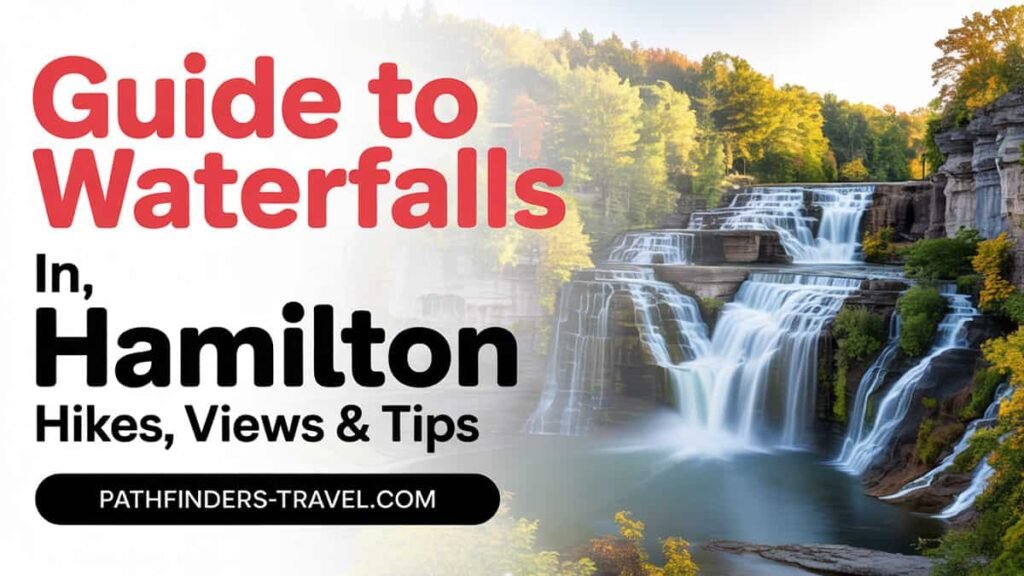Estimated reading time: 20 minutes
Last Modified Date: 15/10/2025
Key Takeaways
- Hamilton is known as the “City of Waterfalls” with over 100 waterfalls within city limits due to the unique geological features of the Niagara Escarpment
- Albion Falls features a stunning fan-shaped cascade with multiple viewing platforms and nearby hiking trails
- Tews Falls is Hamilton’s tallest waterfall at 41 meters high and offers spectacular gorge views
- The Bruce Trail and other Niagara Escarpment pathways provide excellent hiking opportunities with varying difficulty levels
- Swimming is generally prohibited at most Hamilton waterfalls for safety and conservation reasons
Table of Contents
- Introduction
- Hamilton’s Waterfalls & Geographic Significance
- How to Get to Albion Falls
- Hiking to Tews Falls
- Best Trails on the Niagara Escarpment in Hamilton
- Swimming in Hamilton Waterfalls
- Additional Tips & Practical Information
- Frequently Asked Questions about Hamilton Waterfalls
- Conclusion
Introduction
Hamilton proudly wears its title as the City of Waterfalls, a destination renowned for its exceptional natural landscapes that attract waterfall enthusiasts from across the globe. This comprehensive guide to waterfalls in Hamilton introduces you to one of Ontario’s most spectacular natural treasures – a city with over 100 waterfalls cascading through its terrain, each with its own unique character and charm. Whether you’re planning a day trip from Toronto or exploring Ontario’s hidden gems, Hamilton’s waterfalls offer something special for everyone. From gentle hiking trails to panoramic lookout points and potentially refreshing swimming spots, these natural wonders provide endless opportunities for outdoor adventure and photography.
Discover the beauty of Hamilton’s waterfalls and other natural wonders of Ontario in stunning 4K UHD resolution. Visit our YouTube channel now to explore more breathtaking landscapes and hidden gems from Ontario and beyond!
Hamilton’s Waterfalls and the Niagara Escarpment Geography
The spectacular concentration of waterfalls in Hamilton exists thanks to the Niagara Escarpment, a remarkable geological formation that cuts through the city. This UNESCO World Biosphere Reserve creates a dramatic ridge that rises about 100 meters above Lake Ontario within Hamilton’s boundaries. The escarpment’s unique features make it the perfect setting for creating over 100 waterfalls of varying sizes and types.
Geologically speaking, the Niagara Escarpment formed over 400 million years ago when this region was covered by a vast tropical sea. Sediments settled at the bottom of this ancient ocean, eventually hardening into the distinct layers of limestone, shale, and dolostone we see today. Through millions of years of erosion, especially from glacial activity during the last ice age, the escarpment’s distinctive profile emerged with its steep cliff faces.
What makes Hamilton particularly special is how these steep elevation changes interact with the numerous streams and rivers flowing through the city. As water moves from the upper city toward Lake Ontario, it must navigate the escarpment’s sudden drop, creating the perfect conditions for waterfall formation. The varied rock layers play an important role too – harder cap rocks resist erosion while softer underlying shale erodes more quickly, creating the stepped appearance of many Hamilton falls.
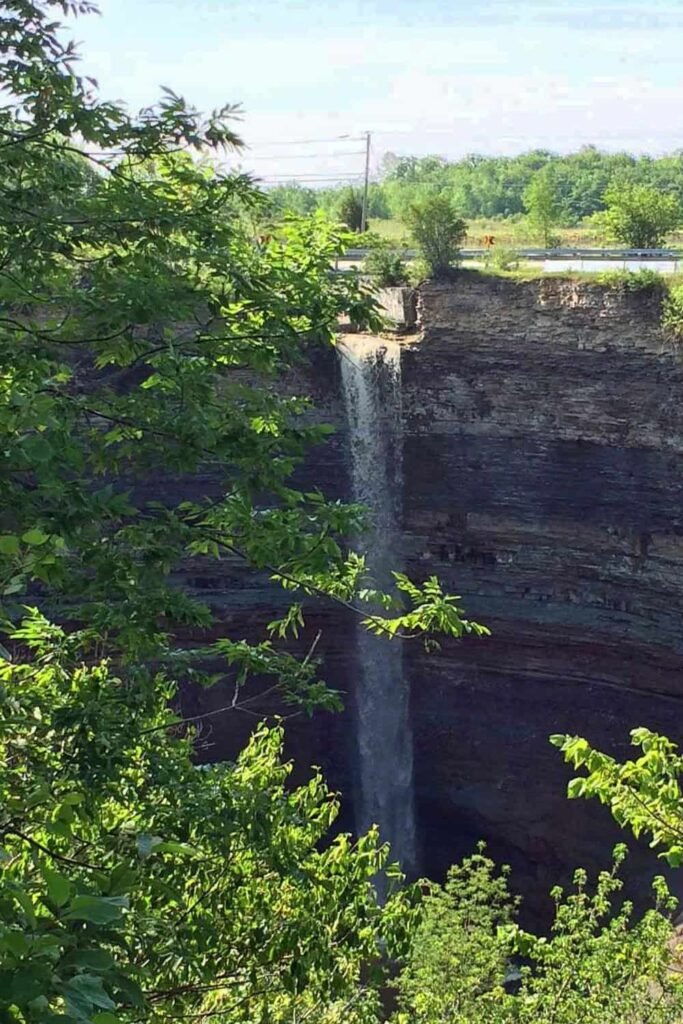
This unique combination of geography, geology, and hydrology has blessed Hamilton with one of the highest concentrations of waterfalls of any urban area in the world. From ribbon-thin cascades to broad curtains of water, each fall has its own character shaped by the specific rock formations and water flow patterns at its location.
Albion Falls Directions, Access, and Visitor Guide
How to Get to Albion Falls: Directions & Transportation
Reaching Albion Falls, one of Hamilton’s most magnificent waterfalls, is relatively straightforward, whether you’re traveling by car or public transit. Located in the east end of Hamilton near the intersection of Mountain Brow Boulevard and Mud Street, this waterfall is among the most accessible in the region [SOURCE].
By car: If you’re coming from Toronto or other parts of the Greater Toronto Area, take the QEW west toward Hamilton, then connect to the Lincoln M. Alexander Parkway (LINC) via the Red Hill Valley Parkway. Exit at Dartnall Road and head north, then turn right onto Stonehenge Drive, which becomes Albion Road. The main parking lot is located at the Mountain Brow Boulevard and Mud Street intersection [SOURCE].
Parking options: The designated Albion Falls parking lot at the intersection of Mountain Brow Boulevard and Mud Street is your best option. This lot can fill quickly on weekends and holidays, so arriving early is advisable. There’s also an overflow lot at the Buttermilk Falls trail entrance nearby. Be extremely cautious about parking elsewhere – the city strictly enforces no-parking zones along Mountain Brow Boulevard and Mud Street with substantial fines [SOURCE].
By public transit: Hamilton Street Railway (HSR) buses serve the Albion Falls area. The closest route typically stops near the intersection of Mud Street and Paramount Drive, requiring a short walk to the falls viewing platforms. Always check the current HSR schedule before planning your trip, as routes and times may change.
Visitor Experience at Albion Falls
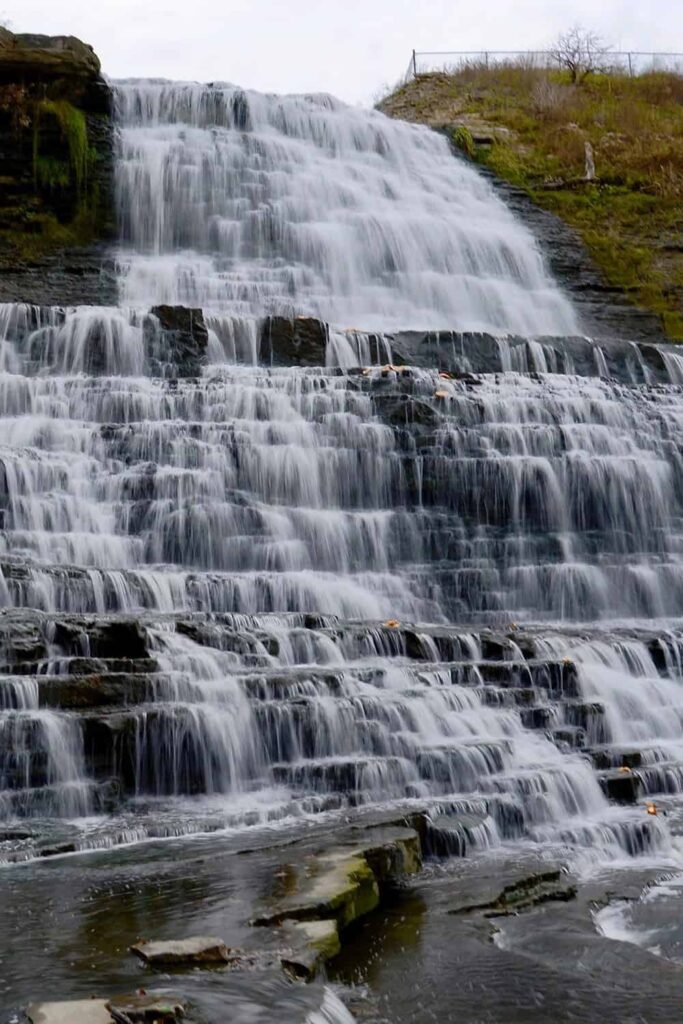
Albion Falls stands out as one of Hamilton’s most impressive waterfalls, featuring a spectacular fan-shaped cascade that drops 19 meters (62 feet) in height and spans approximately 18 meters (60 feet) in width. The waterfall cascades over multiple rock layers in a stepped formation, creating a dramatic effect as water tumbles over different levels of the escarpment [SOURCE].
Upon arrival, you’ll find two main viewing platforms that provide excellent vantage points to admire the falls. These platforms are connected by a short walking trail along the edge of the gorge. While the city has restricted access to the base of the falls and swimming is prohibited, the viewing platforms offer spectacular photo opportunities, especially in the late afternoon when sunlight illuminates the cascading water.
The surrounding Red Hill Valley features picturesque forest trails that allow visitors to explore beyond just the waterfall. The main trail is relatively flat and suitable for most fitness levels, making it an excellent option for families.
For the best experience, visit Albion Falls in the spring when snowmelt and rainfall increase water flow, creating a more dramatic cascade. Early mornings or weekdays typically offer a more peaceful experience with fewer visitors. Fall brings beautiful foliage surrounding the falls, creating stunning color contrasts for photographers.
Hiking to Tews Falls and Dundas Peak Lookout
Trail Details for Hiking to Tews Falls
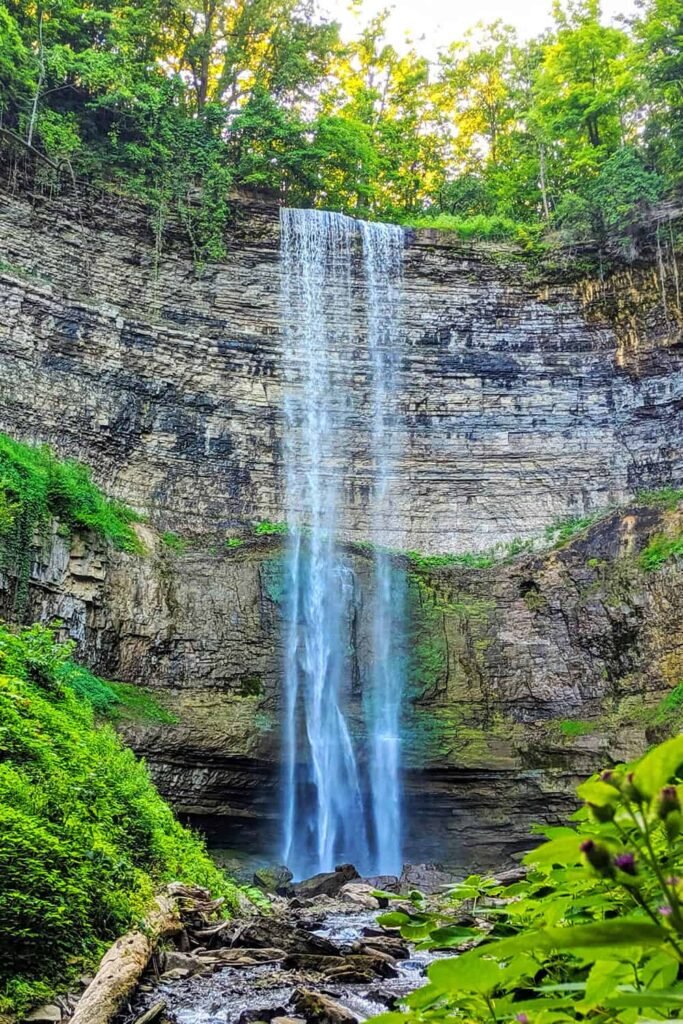
The journey to Tews Falls offers one of the most rewarding hiking experiences in the Hamilton region. Located within the Spencer Gorge Conservation Area, Tews Falls stands as Hamilton’s tallest waterfall at an impressive 41 meters (134 feet) high, just slightly shorter than Niagara Falls. Unlike the broad curtain of Niagara, Tews Falls features a narrow ribbon of water that elegantly cascades down the escarpment face.
The main trail to Tews Falls begins at the designated parking area on Harvest Road in Greensville, a small community west of Hamilton. From the parking lot, it’s approximately a 500-meter walk to reach the viewing platform overlooking the falls. This portion of the trail is relatively easy with minimal elevation change, making it accessible for most visitors. The entire hike to the falls and back covers about 1 kilometer round trip, typically taking 30-45 minutes at a leisurely pace.
For those wanting a more extended adventure, the trail continues past Tews Falls toward Dundas Peak, adding approximately 2 kilometers to your journey. This section involves moderate elevation changes and some uneven terrain. The full loop from the parking area to both Tews Falls and Dundas Peak and back covers roughly 3-4 kilometers and provides some of the most spectacular views in the region.
Gear & Safety for Hiking to Tews Falls
Proper preparation ensures a safe and enjoyable experience when hiking to Tews Falls. Here’s what you should consider bringing:
- Footwear: Sturdy hiking shoes or boots with good traction are essential, especially if continuing to Dundas Peak, where the terrain becomes more challenging
- Water: Carry at least one liter per person, more on hot days
- Weather-appropriate clothing: Layered clothing is best, as temperatures can vary significantly between the top and bottom of the gorge
- Sun protection: Hat, sunglasses, and sunscreen
- Navigation: Trail map or downloaded offline map on your phone
- First aid kit: A basic kit for minor injuries
Safety is paramount when visiting Tews Falls. The trail features steep cliffs with significant drop-offs, particularly along the Spencer Gorge section. Always stay on marked trails and behind safety barriers. The viewing platforms are designed to provide the best vistas while keeping you safe from the cliff edge.
During winter or after rainfall, trails can become extremely slippery. If hiking in winter conditions, consider bringing ice cleats or traction devices for your footwear. After heavy rainfall, some sections may become muddy or even temporarily closed due to safety concerns.
Highlights & Local Insights for Tews Falls and Dundas Peak
Tews Falls offers a dramatically different experience across seasons, making it worth visiting multiple times throughout the year. In spring, melting snow creates powerful water flow, while summer offers lush greenery surrounding the gorge. However, many locals consider autumn the premier time to visit, when the deciduous forest creates a spectacular backdrop of red, orange, and gold foliage around the waterfall.
For photographers, early morning provides the best lighting conditions when the sun illuminates the falls from the east. The late afternoon golden hour can also create stunning backlit effects through the falling water.
While at Tews Falls, consider extending your adventure to include nearby Dundas Peak. This lookout point offers panoramic views of the Spencer Gorge, the town of Dundas, and on clear days, you can see all the way to Lake Ontario. The view from Dundas Peak is particularly breathtaking during fall foliage season, making it one of the most photographed locations in the Hamilton region [SOURCE].
Local tip: During peak season (typically weekends from May through October), the Hamilton Conservation Authority operates a reservation system for Spencer Gorge, including Tews Falls. Visitors must book a time slot in advance through their website. This system helps manage crowds and ensures a more enjoyable experience for everyone.
Best Waterfall Trails along the Niagara Escarpment in Hamilton
Hamilton’s section of the Niagara Escarpment offers some of Ontario’s most spectacular hiking opportunities, with trails ranging from easy walks to challenging hikes, all featuring incredible waterfall views. If you’re looking to explore more of Niagara’s natural wonders, these trails should be on your list.
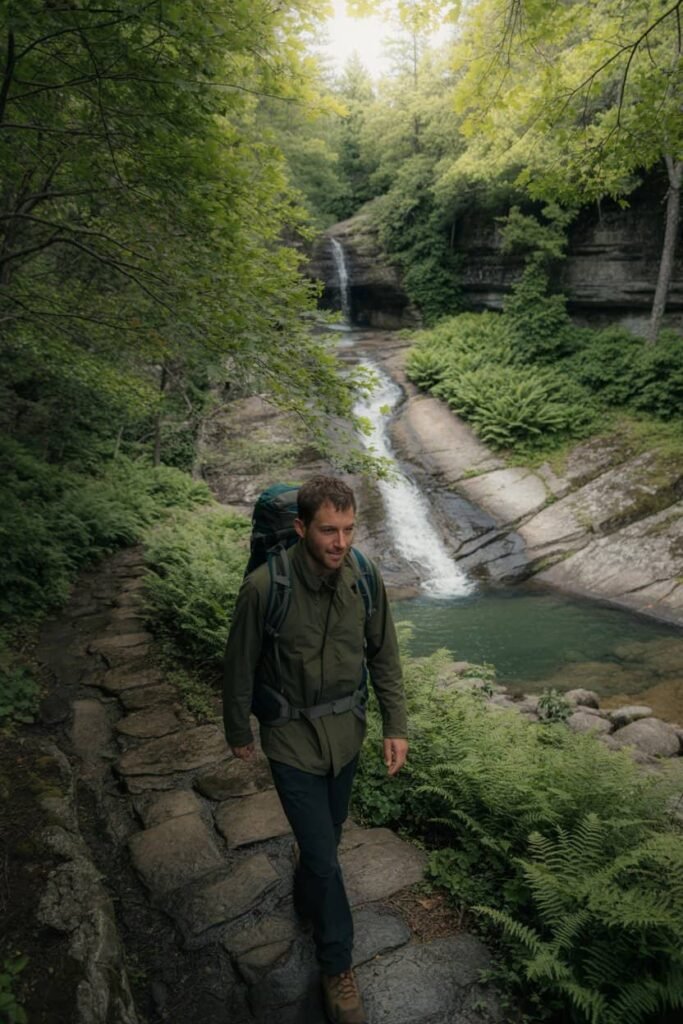
Best Trails on the Niagara Escarpment in Hamilton
Here’s a comparison of the best trails for waterfall exploration in Hamilton:
- Bruce Trail – The crown jewel of hiking in Hamilton, this 900km trail runs along the entire Niagara Escarpment with multiple access points throughout Hamilton. Difficulty: Moderate to challenging. Length: Various sections from 2km to 20+km. Highlights: Access to numerous waterfalls, including Sherman Falls, Canterbury Falls, and Tiffany Falls
- Webster’s Falls and Tews Falls Loop – One of the most popular hikes in the region. Difficulty: Moderate. Length: 3-4km round trip. Highlights: Two spectacular waterfalls and an optional extension to Dundas Peak for panoramic views
- Devil’s Punchbowl Trail – Showcases a unique ribbon waterfall in a colorful rock formation. Difficulty: Easy to moderate. Length: 1.5-2km round trip. Highlights: Stunning geological formations with exposed layers of rock and an upper falls lookout
- Red Hill Valley Trail – A pleasant urban trail running through eastern Hamilton. Difficulty: Easy. Length: 9km one-way. Highlights: Access to Albion Falls and Buttermilk Falls with mostly flat, accessible pathways
- Chedoke Radial Trail – Built on an old railway line, offering a gentler grade. Difficulty: Easy. Length: 2.7km one-way. Highlights: Access to Chedoke Falls and a convenient connection to the Bruce Trail
- Felker’s Falls Conservation Area – A shorter trail with a beautiful 20m waterfall. Difficulty: Easy. Length: Under 1km loop. Highlights: Well-maintained boardwalks and viewing platforms, family-friendly [SOURCE]
Finding Solitude on the Best Trails in Hamilton
While Hamilton’s waterfalls have gained popularity in recent years, there are still ways to enjoy a more peaceful experience on the trails:
- Timing is everything: Visit on weekdays rather than weekends, and arrive early in the morning (before 9 am) or later in the afternoon after 4 pm when day-trippers have started heading home [SOURCE]
- Explore lesser-known falls: While Webster’s Falls and Albion Falls draw crowds, waterfalls like Borer’s Falls, Felker’s Falls, and Sherman Falls tend to be much quieter while still offering beautiful scenery [SOURCE]
- Visit during off-peak seasons: Early spring (April) and late fall (November) can offer solitude along with unique seasonal views of the waterfalls
- Consider weekday visits: If possible, plan your waterfall explorations for weekdays when many trails see significantly fewer visitors
The trail system in Hamilton connects many of these waterfall locations, allowing ambitious hikers to create their own custom routes. The nearby town of Oakville also offers beautiful nature trails that complement a waterfall-focused trip to the region. For an extended exploration of the Bruce Trail and multiple waterfalls, consider starting at the Devil’s Punchbowl and hiking westward toward Albion Falls, which offers access to several falls in a single outing.
Swimming and Safety Rules at Hamilton Waterfalls
The question of swimming in Hamilton waterfalls requires addressing important safety and conservation concerns that every visitor should understand before planning their trip.
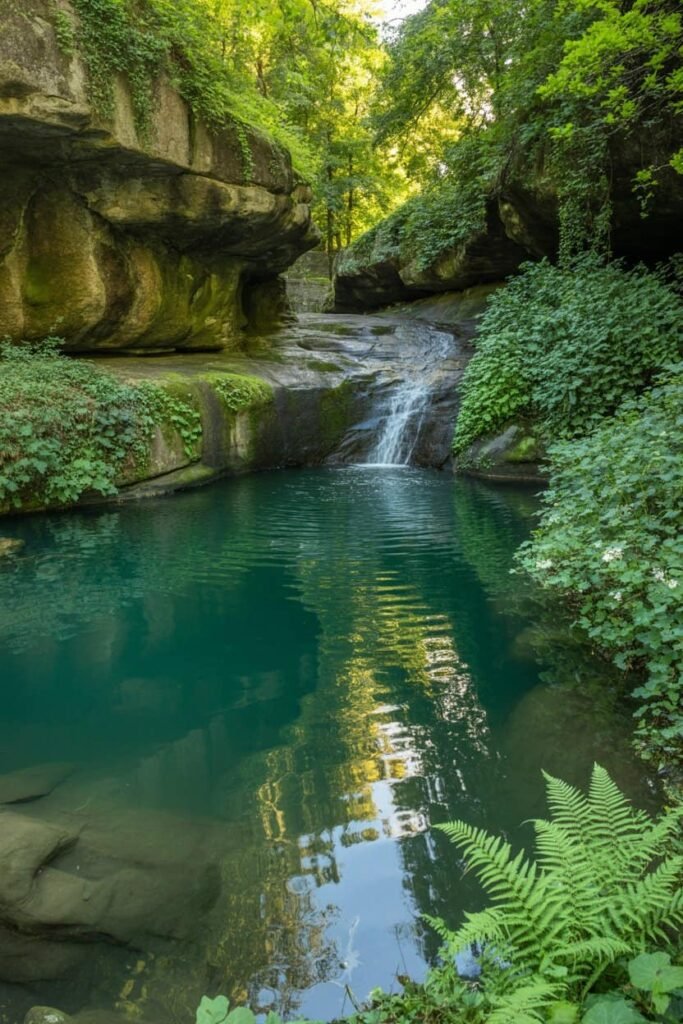
Swimming in Hamilton Waterfalls: Safety and Regulations
First and foremost, it’s crucial to know that swimming is officially prohibited at most of Hamilton’s major waterfalls and their plunge pools. This isn’t arbitrary – these restrictions exist for several important safety reasons:
- Many waterfall areas have hidden underwater hazards, including submerged rocks, fallen trees, and unpredictable currents
- Water depth can change rapidly and unexpectedly, especially after rainfall
- The rock faces around waterfalls are often unstable, with the risk of falling rocks
- Water quality varies significantly and is not regularly tested for swimming safety
- Cold water temperatures, even in summer, can lead to hypothermia or cold shock
- Emergency access to many waterfall locations is difficult, complicating rescue efforts
Local conservation authorities and the City of Hamilton have installed barriers, warning signs, and in some cases, implemented fines for those who ignore safety regulations. These measures intensified after several serious incidents at waterfall sites in recent years.
Historical Swimming Areas at Hamilton Waterfalls
Historically, some waterfall areas in Hamilton were popular informal swimming locations. For instance, the lower pools below Albion Falls and areas around Webster’s Falls were once frequent swimming spots for locals during hot summer days [SOURCE].
However, a combination of safety incidents, environmental concerns, and increasing visitor numbers has led authorities to enforce stricter regulations. Today, access to the base of many falls is either physically restricted or prohibited by municipal bylaw.
Conservation Considerations for Swimming in Hamilton Waterfalls
Beyond safety concerns, there are important environmental reasons for these restrictions:
- The ecosystems around waterfalls are fragile and vulnerable to human impact
- Vegetation along waterfall banks helps prevent erosion and provides wildlife habitat
- Some waterfall areas contain rare plant species or sensitive ecological zones
- Increased foot traffic can damage soil structure and lead to erosion
The Hamilton Conservation Authority works to balance public access with environmental protection, making difficult decisions about restricting certain activities to preserve these natural areas for future generations [SOURCE].
Alternative Swimming Options in Hamilton, Ontario
For visitors hoping to cool off during warm weather, Hamilton offers several safer alternatives:
- Public beaches at Lake Ontario waterfront parks, including Confederation Beach Park and Van Wagner’s Beach
- Supervised public swimming pools throughout the city
- Conservation area beaches with designated swimming areas, such as Christie Lake and Valens Lake
These locations offer the refreshing water experience visitors seek while providing proper safety measures, water quality testing, and in many cases, lifeguard supervision [SOURCE].
Travel Tips and Seasonal Advice for Visiting Hamilton Waterfalls
Making the most of your waterfall adventures in Hamilton requires some planning and preparation. Here are essential tips to enhance your experience while exploring this natural wonderland.
What to Pack for Hiking to Tews Falls and Albion Falls
Proper packing can make a significant difference in your comfort and enjoyment when visiting Hamilton’s waterfalls:
- Footwear: Sturdy hiking shoes or boots with good traction are essential, as many trails can be muddy, rocky, or slippery
- Water: Bring at least one liter per person, more on hot days
- Snacks: Energy bars, fruit, or trail mix for longer hikes
- Camera: Hamilton’s waterfalls offer spectacular photo opportunities
- Weather protection: A light rain jacket, sun hat, and sunscreen
- Insect repellent: Particularly important in spring and summer
- Small first aid kit: For minor scrapes or blisters
- Trail map: Physical or digital maps of the area you’re exploring
Seasonal Considerations for Visiting Hamilton’s Waterfalls
Hamilton’s waterfalls transform dramatically with the seasons, each offering a unique experience:
- Spring (March-May): Peak waterfall flow due to snowmelt and rainfall. Trails may be muddy, but the powerful cascades are at their most impressive
- Summer (June-August): Comfortable hiking weather with lush greenery, though some smaller falls may have reduced flow during dry periods
- Fall (September-November): Spectacular foliage creates stunning backdrops for waterfall photography, especially in October
- Winter (December-February): Frozen or partially frozen falls create magical ice formations. Use extreme caution on trails, which may be icy, and consider ice cleats for your footwear
If you’re interested in exploring more natural wonders in the region, consider visiting the nearby Cheltenham Badlands, which offers another fascinating geological landscape just a short drive from Hamilton.
Hidden Gems Around Hamilton Waterfalls
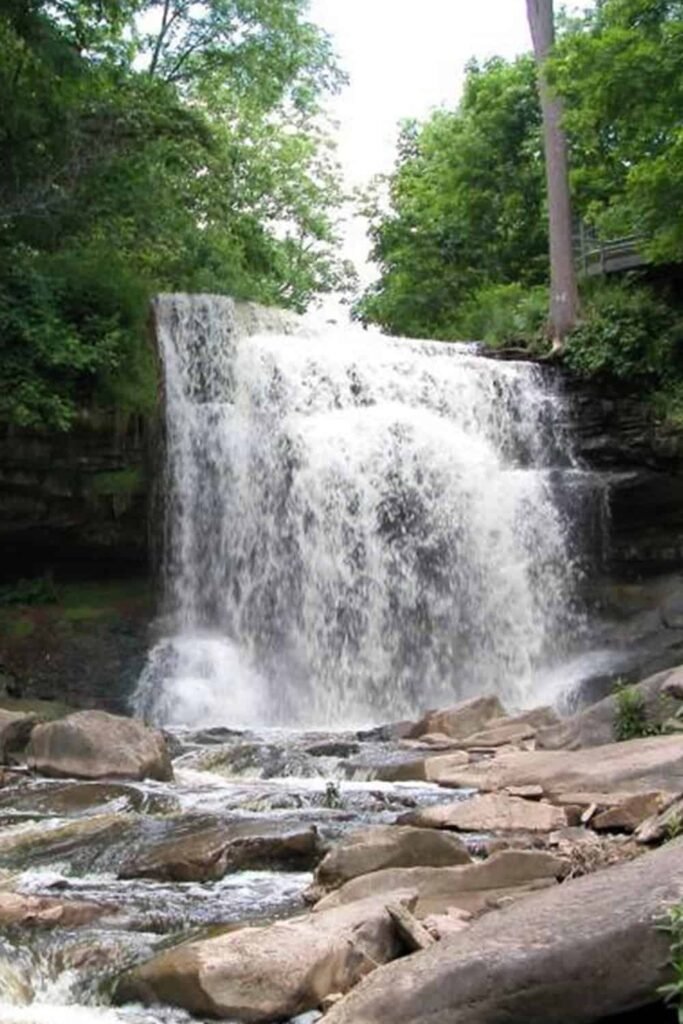
While Albion Falls and Webster’s Falls attract most visitors, Hamilton offers several lesser-known waterfall treasures that provide a more serene experience:
- Billy Green Falls: A small but charming cascade near Devil’s Punchbowl with much smaller crowds
- Hermitage Falls: Located on the grounds of the historic Hermitage ruins in Ancaster, combining history and natural beauty
- Smokey Hollow Falls: A picturesque 10-meter waterfall in Waterdown with a fascinating industrial history
- Great Falls: Also known as Waterdown Falls, this impressive 10-meter waterfall offers good viewing platforms with typically fewer visitors
Parking and Access Tips for Hamilton’s Waterfalls
Navigating the logistics of visiting Hamilton’s waterfalls requires some planning [SOURCE]:
- During peak seasons (summer weekends and fall color season), parking lots at popular falls like Webster’s and Tews Falls fill by mid-morning
- Consider visiting popular sites on weekdays or arriving before 9 am on weekends
- Never park illegally on roadways or in no-parking zones, as enforcement is strict with substantial fines
- Some conservation areas now require advance parking reservations during peak seasons
- Consider using Hamilton’s public transit system (HSR) to access some waterfall locations
With careful planning and respect for regulations, you’ll enjoy a much smoother experience exploring Ontario’s natural attractions, including Hamilton’s magnificent waterfalls.
Frequently Asked Questions about Hamilton Waterfalls
What is the best season to visit Hamilton waterfalls for hiking and photography?
The best times to visit Hamilton’s waterfalls are in spring (March to May) for powerful water flow due to snowmelt and rainfall, and in fall (September to November) when vibrant foliage provides picturesque backdrops. Summer may see reduced flow in smaller waterfalls during dry stretches, while winter offers the chance to see frozen falls with unique ice formations, though trails can be slippery.
How can visitors reach Albion Falls, and what facilities are available nearby?
Albion Falls is located in East Hamilton, at the intersection of Mountain Brow Boulevard and Mud Street. The waterfall is accessible by car via the QEW or Red Hill Valley Parkway, with designated parking nearby. Expect two viewing platforms connected by a short walking trail. Note that access to the base is restricted and swimming is prohibited for safety reasons.
How difficult is the Tews Falls hike, and can it be combined with Dundas Peak or other Hamilton trails?
The hike to Tews Falls is relatively easy, with a one-way distance of about 500 meters and a round-trip distance of 1 km, typically taking 30-45 minutes. For a more extended hike, continue to Dundas Peak, which adds roughly 2 km, and enjoy more moderate terrain. A full loop from the parking area to both Tews Falls and Dundas Peak covers about 3–4 km, offering stunning views of the gorge.
Can you swim at Hamilton waterfalls or nearby conservation areas?
No, swimming is not allowed at Hamilton’s waterfalls due to safety and environmental concerns, including submerged rocks, unpredictable currents, and cold water temperatures. For water activities, consider visiting designated beaches and public swimming pools in the city or conservation areas with lifeguards and water testing.
What should travelers pack for Hamilton waterfall hikes, and how can they avoid peak crowds?
Pack sturdy hiking shoes with good grip, plenty of water (at least 1 L per person), sun protection, layered clothing, and insect repellent. To avoid crowds, visit waterfalls during weekdays or early in the morning and explore lesser-known falls like Borer’s Falls, Billy Green Falls, or Hermitage Falls. Visiting off-peak seasons, like early spring or late fall, also ensures a quieter experience.
Conclusion
Hamilton’s recognition as the City of Waterfalls is well-deserved, offering a wealth of natural wonders shaped by the Niagara Escarpment. From the stunning drop of Albion Falls to the impressive height of Tews Falls, each waterfall tells the story of a landscape sculpted by millions of years of geological processes.
These waterfalls are more than just beautiful photo opportunities; they are a testament to the area’s rich natural history and provide a range of outdoor experiences suitable for all levels of hikers. As you explore Hamilton’s waterfalls, be sure to follow responsible tourism practices, ensuring that these extraordinary sites remain protected for future generations.
Whether you’re an avid hiker, a photography enthusiast, or simply someone looking to connect with nature, Hamilton’s waterfalls promise something for everyone. If you’re planning a broader adventure in Ontario, don’t forget to explore the surrounding attractions, like the hidden gems of Ontario, for a more immersive experience.
We hope this guide has inspired your own waterfall adventure in Hamilton. Share your favorite falls or tips in the comments below, and don’t forget to check out Pathfinders Travel on YouTube for more stunning travel documentaries showcasing the wonders of the world in breathtaking 4K resolution.

